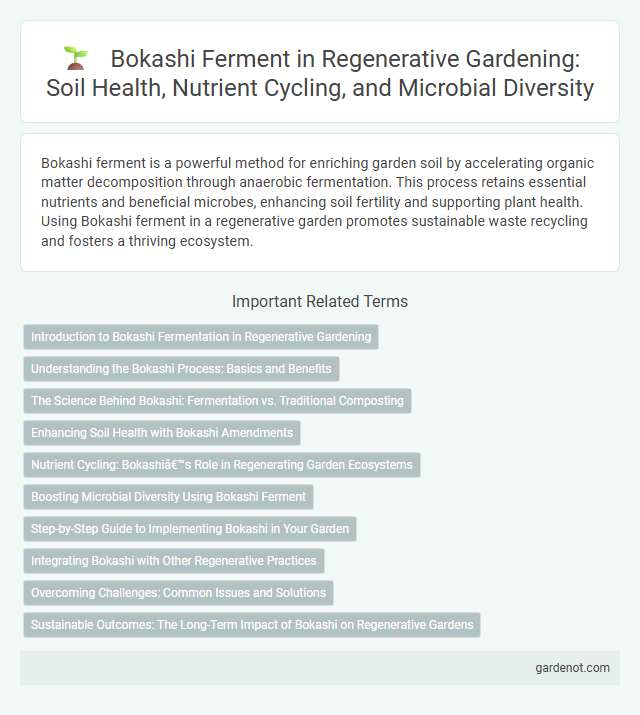Bokashi ferment is a powerful method for enriching garden soil by accelerating organic matter decomposition through anaerobic fermentation. This process retains essential nutrients and beneficial microbes, enhancing soil fertility and supporting plant health. Using Bokashi ferment in a regenerative garden promotes sustainable waste recycling and fosters a thriving ecosystem.
Introduction to Bokashi Fermentation in Regenerative Gardening
Bokashi fermentation is an anaerobic process that utilizes effective microorganisms (EM) to rapidly decompose kitchen scraps and organic waste into nutrient-rich compost. This method enhances soil fertility by preserving essential nutrients and improving microbial activity, making it a key technique in regenerative gardening. Integrating bokashi ferment in garden systems accelerates organic matter recycling while reducing greenhouse gas emissions compared to traditional composting.
Understanding the Bokashi Process: Basics and Benefits
Bokashi ferment is an anaerobic fermentation process that utilizes effective microorganisms (EM) to break down organic waste rapidly, enriching soil with beneficial microbes and nutrients. This method produces nutrient-dense bokashi compost that improves soil structure, enhances microbial diversity, and accelerates nutrient cycling in regenerative gardens. Incorporating bokashi ferment reduces landfill waste and supports sustainable gardening by promoting healthy plant growth and resilience.
The Science Behind Bokashi: Fermentation vs. Traditional Composting
Bokashi fermentation utilizes anaerobic microbes to rapidly break down organic matter, producing nutrient-rich bokashi bran that enhances soil health. Unlike traditional composting, which relies on aerobic decomposition and can take months, bokashi fermentation completes in just two weeks through lactic acid bacteria, yeasts, and phototrophic bacteria. This process preserves more nitrogen and beneficial microbes, enriching regenerative garden ecosystems with faster nutrient cycling and improved soil structure.
Enhancing Soil Health with Bokashi Amendments
Bokashi ferment enriches soil health by introducing a diverse community of beneficial microorganisms that accelerate organic matter decomposition and nutrient cycling. Its anaerobic fermentation process preserves valuable nutrients, reducing nitrogen loss and improving soil structure and fertility. Incorporating Bokashi amendments boosts microbial activity, enhances soil aeration, and increases nutrient availability, promoting robust plant growth and sustainable regeneration.
Nutrient Cycling: Bokashi’s Role in Regenerating Garden Ecosystems
Bokashi ferment accelerates nutrient cycling by breaking down organic waste into rich, bioavailable compost that revitalizes soil microbial activity. This process enhances nitrogen, phosphorus, and potassium availability, supporting robust plant growth and improving soil structure. Integrating Bokashi ferment into garden ecosystems promotes sustainable nutrient reuse and long-term soil fertility regeneration.
Boosting Microbial Diversity Using Bokashi Ferment
Bokashi ferment enhances soil health by introducing a rich diversity of beneficial microbes, including lactic acid bacteria, yeasts, and phototrophic bacteria, which accelerate the decomposition of organic matter. This microbial diversity improves nutrient cycling, suppresses soil pathogens, and promotes plant growth in regenerative gardens. Regular application of Bokashi ferment stimulates a balanced soil microbiome, increasing resilience against environmental stress and enhancing long-term soil fertility.
Step-by-Step Guide to Implementing Bokashi in Your Garden
Begin your Bokashi fermentation process by mixing organic waste, such as fruit peels, vegetable scraps, and coffee grounds, with Bokashi bran inoculated with effective microorganisms (EM). Layer the mixture in an airtight container, compressing each layer to remove oxygen and ferment for two to four weeks, ensuring anaerobic conditions to promote beneficial microbial activity. After fermentation, bury the fermented waste in your garden soil to enrich it with nutrients, improve soil structure, and enhance plant growth through natural decomposition.
Integrating Bokashi with Other Regenerative Practices
Integrating Bokashi ferment with other regenerative practices enhances soil fertility by accelerating organic matter breakdown and increasing microbial diversity. Combining Bokashi with cover cropping and no-till farming promotes nutrient cycling and improves soil structure, leading to healthier plant growth. Utilizing Bokashi alongside compost teas and mulching further supports vibrant soil ecosystems and sustainable garden productivity.
Overcoming Challenges: Common Issues and Solutions
Bokashi ferment often faces challenges such as odor issues, slow fermentation, and mold growth, which can be mitigated by maintaining the right moisture level, using the correct ratio of bokashi bran, and ensuring proper airtight conditions. Troubleshooting these common problems involves adjusting the ingredients to maintain anaerobic environments and preventing contamination by regularly cleaning tools and containers. Consistent temperature control and careful layering of organic waste with bokashi bran also promote successful fermentation and nutrient-rich compost output.
Sustainable Outcomes: The Long-Term Impact of Bokashi on Regenerative Gardens
Bokashi ferment enriches soil by accelerating organic matter decomposition, enhancing nutrient retention, and promoting microbial diversity critical for regenerative garden health. Its sustainable outcomes include improved soil structure, increased crop yields, and reduced reliance on chemical fertilizers, contributing to long-term ecosystem resilience. The continuous use of Bokashi supports carbon sequestration and water retention, essential for maintaining productive and sustainable regenerative gardens.
Bokashi ferment Infographic

 gardenot.com
gardenot.com